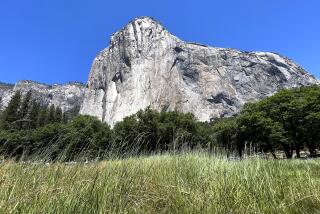6 California parks could revert to federal control
- Share via
The National Park Service has informed Gov. Arnold Schwarzenegger that his budget-cutting proposal to indefinitely close 220 California state parks could compel the federal government to take control of six parks that occupy former U.S. property, including Angel Island in San Francisco Bay, Point Sur State Historic Park in coastal Big Sur and Point Mugu State Park near Malibu.
In a June 8 letter, Jon Jarvis, regional director of the park service, reminded the governor that the terms of the agreement that transferred federal lands to the state require that unless the parks are open to the public “in perpetuity,” the property could revert to government hands.
Schwarzenegger’s current budget calls for closing at least 80% of California’s state park system, for a projected saving of $143 million. Democrats have suggested a $15 vehicle license fee surcharge to continue funding the parks, which the governor and other Republicans have so far rejected.
The park service characterized the two-page letter -- which surfaced last week -- as informational.
“We saw the list of potential park closures and we thought the governor needed to know the potential consequences of closing the parks, given the agreement,” said David Siegenthaler, a program manager at the National Park Service.
The government has conveyed six parcels to California under the Federal Lands to Parks Program, which is intended to convert surplus federal property to open space and increase recreational opportunities. Those sites are Angel Island, a former Civil War and World War II military compound and immigration facility in San Francisco Bay; the top of Mt. Diablo east of San Francisco, where the Navy once operated a microwave relay station; Point Sur State Historic Park in coastal Big Sur; and three beaches: Fort Ord Dunes near Monterey, Point Mugu State Park near Malibu and Border Fields along the Mexican border.
No one in the park service wants to take control of California’s parks, the agency says, but it is bound by the terms of the land transfer to ensure the public has access to the parks.
“We’re not trying to bully them or take a strong arm,” Siegenthaler said. “But they are agreements. We’re trying to work with the state to find ways to keep the parks open.”
The state’s parks director, Ruth Coleman, has been in discussions with the park service, according to state parks spokesman Roy Stearns.
“It’s important to note that nobody is proposing to close these parks permanently. This is a temporary suspension until budget times are better,” Stearns said. “We have no intention of giving them away or selling them. There’s an interest in finding a way to preserve and protect them. It could be temporary federal control. We would hope they can come back to state parks.
“We are all wondering what’s next.”
There’s more than control of a handful of parks at stake; there’s million of dollars in federal funds. The park service’s Jarvis wrote that closed state parks may no longer qualify for money from the Land and Water Conservation Fund, which provides grants for land acquisition and other projects. California has received about $286 million from the fund since 1965, affecting 67 of the state parks on the potential closure list, Jarvis wrote. Six other state parks have active conservation fund grant projects that would lose their funding, he added.
The governor is aware of the problem, but “there are no good options,” Schwarzenegger spokeswoman Lisa Page said Friday.
As the impasse continues in Sacramento, temporarily locking the gates of the nation’s largest state park system seems an ever more realistic outcome.
Elizabeth Goldstein, president of the California State Parks Foundation, said she’s concerned that there are few alternatives open to the governor and state Legislature, and she bemoans the loss to the public.
“Our parks represent icons, the redwood forest to the Inland Empire,” Goldstein said. “We’re talking about shutting off access to 30% of the coastline of California. And there’s a direct connection between parks and the economic viability of communities near parks. We take this threat very seriously until it’s off the table.”
--
More to Read
Sign up for Essential California
The most important California stories and recommendations in your inbox every morning.
You may occasionally receive promotional content from the Los Angeles Times.














